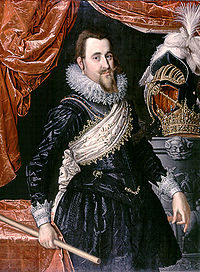
Pieter Isaacsz
Encyclopedia
Pieter Isaacsz was a Dutch Golden Age
painter.
 According to van Mander his father was from Haarlem
According to van Mander his father was from Haarlem
and he learned to paint in Amsterdam
for a year and a half by Cornelis Ketel
, and later by Hans von Achen. Van Mander claimed he still lived in Amsterdam and went on to describe several portraits by him which he particularly admired, including a half-length portrait of Sara Schurmans playing a citar. His most popular piece was an oil-on-copper painting with a procession of angry women in Rome on hearing that the Senate had decided in favor of polygamy for men.
According to Houbraken (who mistakenly called him Pieter Fransz) he later became the teacher of Adriaen van Nieulandt the younger
.
According to the RKD he travelled back and forth to Denmark several times, which is possibly where he later died.
He was the subject of an exhibition at Frederiksborg Palace
in 2007 as the man behind the collection's most famous portraits. According to Codart he was court painter of the Danish king Christian IV who became a spy in Swedish service and died of the plague in Elsinore.
Dutch Golden Age
The Golden Age was a period in Dutch history, roughly spanning the 17th century, in which Dutch trade, science, military and art were among the most acclaimed in the world. The first half is characterised by the Eighty Years' War till 1648...
painter.
Biography

Haarlem
Haarlem is a municipality and a city in the Netherlands. It is the capital of the province of North Holland, the northern half of Holland, which at one time was the most powerful of the seven provinces of the Dutch Republic...
and he learned to paint in Amsterdam
Amsterdam
Amsterdam is the largest city and the capital of the Netherlands. The current position of Amsterdam as capital city of the Kingdom of the Netherlands is governed by the constitution of August 24, 1815 and its successors. Amsterdam has a population of 783,364 within city limits, an urban population...
for a year and a half by Cornelis Ketel
Cornelis Ketel
Cornelis or Cornelius Ketel was a Dutch Mannerist painter, active in Elizabethan London from 1573 to 1581, and in Amsterdam from 1581 to the early 17th century, now known essentially as a portrait-painter, though he was also a poet and orator, and from 1595 began to sculpt as well.According to...
, and later by Hans von Achen. Van Mander claimed he still lived in Amsterdam and went on to describe several portraits by him which he particularly admired, including a half-length portrait of Sara Schurmans playing a citar. His most popular piece was an oil-on-copper painting with a procession of angry women in Rome on hearing that the Senate had decided in favor of polygamy for men.
According to Houbraken (who mistakenly called him Pieter Fransz) he later became the teacher of Adriaen van Nieulandt the younger
Adriaen van Nieulandt the younger
Adriaen van Nieulandt the Younger was a Dutch painter and engraver of the Baroque period.-Biography:...
.
According to the RKD he travelled back and forth to Denmark several times, which is possibly where he later died.
He was the subject of an exhibition at Frederiksborg Palace
Frederiksborg Palace
Frederiksborg castle is a castle in Hillerød, Denmark. It was built as a royal residence for King Christian IV, and is now known as The Museum of National History. The current building replaced a previous castle erected by Frederick II, and is the largest Renaissance palace in Scandinavia...
in 2007 as the man behind the collection's most famous portraits. According to Codart he was court painter of the Danish king Christian IV who became a spy in Swedish service and died of the plague in Elsinore.

